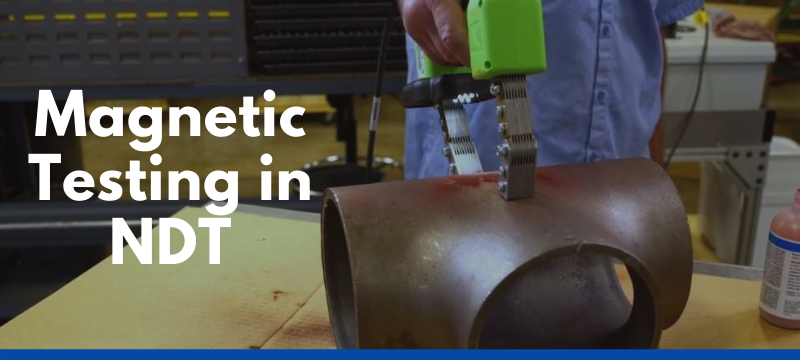
16 Aug Magnetic Testing In NDT – Course Details And Syllabus
What is Magnetic Testing?
Magnetic testing is also known as magnetic particle inspection which is a type of non-destructive testing. Magnetic testing involves the detection of surface and also the shallow subsurface flaws in most of the ferromagnetic materials. This testing allows to detect the effects which are invisible to the naked eye. Magnetic particle inspection is mainly used in the ferromagnetic materials like nickel, cobalt, iron and few alloys. It is usually considered as a method for surface examination.
Usually magnetic testing is used for the detection of defects such as pores, cracking, lack of sidewall fusion especially in welds, cold lap etc in magnetic materials. The objective behind magnetic testing is to find the defects by using the presence of flux leakage fields created by the magnetic field. Magnetic particle inspection can be tested on all metals which can undergo strong magnetization, but not for austenitic stainless steels.
What is the basic principle in Magnetic Testing?
Magnetic testing can be considered as a fusion of two types of NDT methods which are visual testing and magnetic flux leakage testing. The basic principle behind magnetic particle inspection is the presence of magnetic flux leakage fields. First the inspecting sample is magnetized and the magnetic field will spread out on the surfaces and the subsurfaces where there is an air gap which is created by the formation of cracks. This spreading out of the magnetic field appears as a leak from the surface of the material and is called flux leakage field. So this flux leakage field is created on all defects on the surfaces and the subsurfaces. Once the material is magnetized, the iron particles are sprinkled either in wet or dry form on the surfaces.This will allow the particles to get attracted and cluster at the magnetic flux leakage fields which make the defects visible to the inspector.
Materials Used in General (Varies depending on the type)
- Wet horizontal Magnetic Particle Inspection machine: Commonly used mass-production machine for MPI.
- Mobile Power Packs: Custom-built magnetizing power supplies mainly used for wire wrapping applications.
- Magnetic yoke: Hand-held device which induces a magnetic field.
Process or Steps involved in Magnetic Testing
- Pre-cleaning the surface.
- Demagnetizing, if required.
- Sample is induced with a magnetic field.
- Application of magnetic particles on the sample.
- View and inspect the surface for the cluster formation to identify the defects.
- Demagnetizing the sample.
- Cleaning the surface
Different Methods of Magnetization
- By passing a large current through the sample
- By the application of electro-magnet or permanent magnet to the surface
- By allowing threading through a hollow sample using a current-carrying bar
- By making the sample the secondary loop of a transformer
- By placing a loop or current-carrying coil close to the sample surface;
- By putting the sample inside a current-carrying coil, or by forming a coil around the sample
Advantages and disadvantages of Magnetic Testing
Advantages
- Inspection can be done directly on the surface and can have a visual indication of the defects
- Only minimal limitations for the materials
- Can be used to inspect parts with complex and irregular shapes
- Portable inspection formats
- Inexpensive testing method
- Sensitivity is high so that it can detect even small discontinuities
- Fast inspection with rapid results
Disadvantages
- Pre- cleaning is required since the defects can be covered with dirt or contaminants
- The magnetic flux and the defect alignment should be considered importantly
- Multiple processes should be performed
- Inspection can be performed only on relative nonporous surfaces
- Surface defects can only be identified
- Post cleaning and post demagnetization is necessary
- Sample should be of ferromagnetic type
- Proper disposal with chemical handling is necessary
Enroll for 1 month preparatory classes for ASNT level 2 and 3 Magnetic Testing Certification
Gamma NDT academy offers NDT preparatory classes for candidates who intend to appear for the ASNT Level 2 and 3 Magnetic Testing certification exam.
We will cover all the syllabus under ASNT for Magnetic testing and conduct mock tests to prepare you best for the certification exam. We will also share study materials and sample questions which you need to revise. We have a 100% success rate for NDT level 2 and 3 certification courses.
Gamma NDT academy training institute is located in Kerala, India. We provide online classes for candidates who cannot attend our training sessions in-person.



No Comments